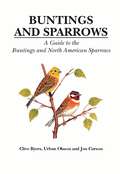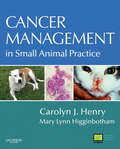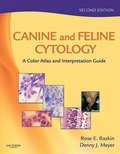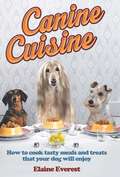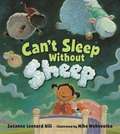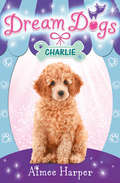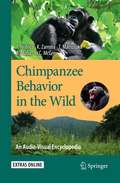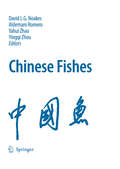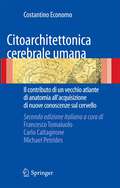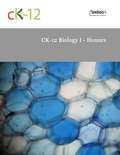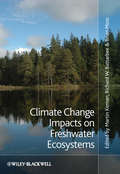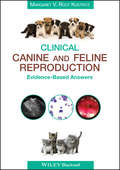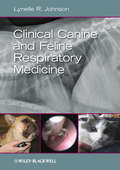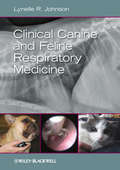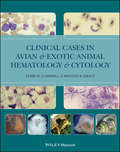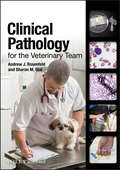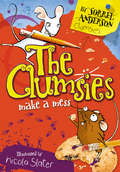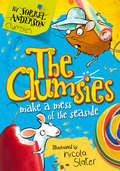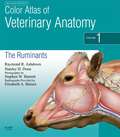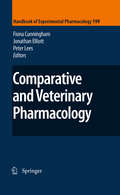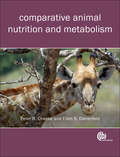- Table View
- List View
Buntings and Sparrows: A Guide To The Buntings And North American Sparrows (Helm Identification Guides)
by Clive Byers Urban Olsson Jon CursonBuntings and North American sparrows offer a great identification challenge. Many of the long distance migrants are notable wanderers, with a strong tendency to vagrancy, while others are rare and local. Some of the Asian buntings and tropical sparrows are still poorly known, and the skulking habits of some species add to the challenge. Most male buntings acquire a bright plumage, but the American sparrows acquire this exceptionally, rather than as the rule. Many sparrows and female buntings appear to be rather dull brown birds, but a closer look will reveal intricate and often quite beautiful plumage; with these birds, the field marks that will enable positive identification are to be found in minute feather detail. This book is the first comprehensive guide to all the Old World buntings and North American sparrows. It includes 39 plates in full colour depicting all the species and distinct races. In the systematic section each species account is divided into sections: the identification section summarises important field marks; the description section details plumage and bare part characteristics for all ages and sexes; geographical variation covers taxonomy, and other sections give detailed measurements, descriptions of moult and ageing, habits, voice, status and habitat, distribution and movements, and references. A range map is included for each species. This beautifully presented book will for many years to come help solve the identification problems posed by a delightful and sought-after family of birds.
Cancer Management in Small Animal Practice - E-Book
by Carolyn J. Henry Mary Lynn HigginbothamCancer Management in Small Animal Practice provides you with all the tools needed to diagnose, stage, and manage the many different disease entities known as "cancer." This manual is designed to provide you with easy-to-access, clinically relevant details for complete care of the small animal cancer patient, while considering the needs, concerns, and capabilities of the client. It provides quick reference sections for information not included in current oncology texts, including drug interactions and resources for participation in clinical trials. All information is well referenced and the reference section on the accompanying website includes links to the original and related articles.The latest information including diagnostic procedures, treatment modalities, and outcome predictions to help clients make the best decisions for their pets. Expert contributors, renowned for clinical, as well as academic and research expertise, offer a wide breadth and depth of expertise. Full-color format provides accurate visual depictions of specific diseases and procedures to enhance your diagnostic capabilities. Key Points highlight critical information, enabling quick, easy access. Systems approach to diagnosis and management offers logical, systematic, head-to-tail procedure for accurate diagnosis, treatment, and prognosis. Extensive discussions of supportive care limit adverse events and increase patient survival and puts emergency information at the practitioner’s fingertips. Suggested readings highlight the latest information for further investigation and research. Comprehensive drug safety guidelines thoroughly discuss all information required to safely handle and administer cancer drugs. Helpful drug formularies offer available formulations, recommended dosages, toxicities, and relative costs. Chapter on how to access clinical trials provides helpful information and hope for patients and their caregivers.
Canine and Feline Cytology - E-Book: A Color Atlas and Interpretation Guide
by Rose E. Raskin Denny MeyerMaster the art and science of specimen collection, preparation, and evaluation with Canine & Feline Cytology: A Color Atlas and Interpretation Guide, Second Edition. This easy-to-use guide covers all body systems and fluids including a special chapter on acquisition and management of cytology specimens. Hundreds of vivid color images of normal tissue alongside abnormal tissue images – plus concise summaries of individual lesions and guidelines for interpretation - will enhance your ability to confidently face any diagnostic challenge. A greatly expanded image collection, with more than 1,200 vivid, full-color photomicrographic illustrations depicting multiple variations of normal and abnormal tissue for fast and accurate diagnosis Clear, concise descriptions of tissue sampling techniques, slide preparation and examination guidelines Helpful hints for avoiding technical pitfalls and improving diagnostic quality of specimens Includes all body systems and fluids as well as pathological changes associated with infectious agents Histologic and histopathologic correlates provided in all organ system chapters. User-friendly format and logical organization facilitates readability and learning. Expert contributors represent the most respected leaders in the field. NEW! Chapter on Fecal Cytology Highlighted boxes featuring Key Points provide helpful tips for best conceptual understanding and diagnostic effectiveness Photomicrographs now include more comparative histology Discussions of broader uses of stains and immunocytochemistry for differential cytologic characterization Expanded chapter on Advanced Diagnostic Techniques includes more methodology and application of current tools, representing advances in both aspiration and exfoliative cytology.
Canine Cuisine: How to cook tasty meals and treats that your dog will enjoy
by Elaine EverestEvery dog owner wants the best for their pet. Commercial dog foods and biscuits contain colourings, flavour enhancers and preservatives that are just as unlikely to be good for our pets as they are for us. The only way we can know that our beloved dog is getting a healthy and nutritionally balanced diet is if we prepare their food ourselves. In this book, Elaine Everest provides over 100 tasty and nutritional recipes for every occasion, from main meals cooked with organic ingredients to kibble and mixer biscuit substitutes and delicious biscuits and treats to supplement their diet. There are even recipes for cakes that can be specially baked to celebrate birthdays and other fun occasions. Healthy treats that will keep dogs lean and fit. Easy to prepare daily meals, even for the non-cooks amongst us. Easy to make training titbits, plus recipes to cook and freeze Cooling snacks for hot days. Vegetarian meals, slimming meals and special diets for happy hounds. With this handy book you'll never again need to purchase mass produced treats for your dog - and you'll save money too.Contents: Acknowledgements; 1. Why Cook for Our Dogs?; 2. Biscuits and Everyday Treats 3. Cook and Freeze; 4. Daily Recipes; 5. Birthdays and Celebration Food; 6. Training Treats 7. Kibble and Mixer Biscuit; 8. Fundraising and Presents; 9. Hot Dog Coolers; 10. Weight Control and Other Diets; 11. Sauces and Gravies; 12. Foods that Are Dangerous for Dogs; Appendix 1: Oven Temperatures; Appendix 2: Recommended Retailers and Books; Index.
Can't Sleep Without Sheep
by Mike Wohnoutka Susanna Leonard HillWhenever Ava can't sleep, she counts sheep. But Ava takes so long to fall asleep, it's the sheep that are growing tired-until finally, they quit! When the sheep promise to find a replacement that Ava can count on, chaos ensues as chickens, cows, pigs, hippos, and more try their hand at jumping over Ava's fence. Finding the perfectly peaceful replacement for sheep might not be so easy after all.With irresistibly adorable art, this delightful take on a familiar sleep tactic is sure to become a bedtime favorite.
Charlie (Dream Dogs #5)
by Aimee HarperThe fifth exciting adventure from the gorgeous series set in a glamorous pooch parlour, for animal-crazy girls who love dogs and looking after them.
Chimpanzee Behavior in the Wild: An Audio-Visual Encyclopedia
by Toshisada Nishida Koichiro Zamma Agumi Inaba Takahisa Matsusaka William C. McGrewWhere We Stand Field workers—scientists of animal (including human!) behavior in nature—have long been fascinated by wild chimpanzees. A person who once has studied wild chimpanzees will be eager to observe them again. A person who has studied them twice will make every effort to continue the study, unless prevented from doing so. In short, behavioral primatology is addictive! Many people, among them Jane Goodall, Richard Wrangham, and I, do not regret that they have dedicated their whole lives to the study of wild chimpanzees. This is because the apes’ behavior is always challenging: chimpanzees are cheerful, charming, playful, curious, beautiful, easygoing, generous, tolerant, and trustw- thy most of the time, but also are cautious, cunning, ugly, violent, ferocious, blo- thirsty, greedy, and disloyal at other times. We human beings share both the light and dark sides with our closest living relatives. For decades, we have documented huge across-population variation in behavior, as well as within-population variation. Cultural biology (now called cultural pri- tology), as proposed 60 years ago by Kinji Imanishi, recently has flourished.
Chinese Fishes (Developments in Environmental Biology of Fishes #28)
by Yahui Zhao Yingqi Zhou David L. G. Noakes Aldemaro RomeroThis book documents the current state of research by Chinese scientists on fish biology and fisheries and brings together manuscripts by authors from research institutions, universities and government agencies. There are papers on aquaculture, life history, genetics, marine and freshwater biology, conservation, physiology, new species descriptions, and truly amazing hypogean fishes. The information on these remarkable cave species shows how much we have yet to learn from that incredible fauna. There are papers dealing with some of the largest fishes and some of the smallest cave species. There are papers dealing with some of the most traditional forms of aquaculture and others with the most modern molecular techniques. The volume includes papers on critically threatened native fishes as well as the most common food species, such as grass carp (Ctenopharyngodon idella). The information on rare and threatened species shows how China is dealing with their endangered fishes. The information on their carp species will be invaluable to those in other countries who will either take advantage of the productive carp species in aquaculture or try to manage them as invasive species outside China. For the first time we bring together a complete overview of the state of fisheries research in China.
Citoarchitettonica cerebrale umana: Il contributo di un vecchio atlante di anatomia all’acquisizione delle nuove conoscenze sul cervello.
by Francesco Tomaiuolo Carlo Caltagirone Michael PetridesNel 1925, Economo e Koskinas pubblicarono l’atlante più accurato e completo sulla citoarchitettonica della corteccia cerebrale umana mai realizzato. Una sintesi del contenuto dell'atlante venne in seguito resa disponibile in tedesco e tradotta in italiano, inglese e francese. Il valore scientifico di quest'opera è divenuto più significativo negli ultimi vent’anni con l'avvento delle tecniche di neuroimaging funzionale, le quali consentono persino di rilevare specifici focolai di attivazione nella corteccia cerebrale umana durante l’esecuzione di compiti cognitivi. Questa riedizione in italiano è stata ampliata rispetto all'originale con l'aggiunta della mappa dei solchi e dei giri del cervello. Inoltre, è stata inclusa la tabella delle corrispondenze tra le aree individuate da Economo e Koskinas e quelle descritte da Brodmann. Il volume sarà di grande interesse per tutti coloro che desiderano approfondire la relazione tra la struttura del cervello e le sue funzioni; rappresenterà inoltre un utile strumento di lavoro per i professionisti che utilizzano le neuroimmagini nella loro pratica quotidiana, quali neurofisiologi, neuropsicologi, neuroradiologi, neurologi e neurochirurghi.
CK-12 Biology I - Honors
by Ck-12 FoundationCK-12 Foundation's Biology 1- Honors FlexBook Covers the following chapters:<P><P> Foundations of Life Science- scientific investigations, methods, observations, & communication.<P> Chemical Basis of Life- matter, the significance of carbon, lipids, proteins.<P> Cell Structure and Function- prokaryotic, eukaryotic, plant, & animal cell features; structures / functions of DNA, RNA, protein, cell transport, homeostasis.<P> Photosynthesis- water, carbon, and nitrogen cycle between abiotic and biotic resources.<P> Cellular Respiration- relation to glycolysis, Krebs Cycle, electron transport chain.<P> Cell Division and Reproduction- cell division, reproduction.<P> Mendelian Genetics- inheritance, sex-linked traits.<P> Molecular Genetics- DNA, RNA, protein synthesis, mutation, regulating gene expression.<P> Human Genetics- human genome, diseases, Biotechnology- DNA technology, gene cloning.<P> History of Life- evolution, macroevolution, extinctions, episodic speciation, response to change.<P> Evolutionary Theory- Darwin's Theory of Evolution, common ancestry and natural selection.<P> Evolution in Populations- genetics of populations, genetic diseases, natural selection.<P> Classification- Taxonomy, scientific classification of organisms.<P> Principles of Ecology- Ecology's relation with energy; ecosystems, the water, carbon, and nitrogen cycles.<P> Biomes, Ecosystems and Communities- terrestrial/ aquatic biomes, community interactions.<P> Populations- Analysis of populations and dynamics.<P> Ecology and Human Actions- Balance between humans and the earth addressing natural resources, ecosystems, & biodiversity.<P> The Human Body- systems.<P> Nervous and Endocrine Systems- structures & functions, homeostasis.<P> Skeletal, Muscular, and Integumentary Systems- structures, functions, & homeostasis.<P> Circulatory and Respiratory Systems- structures and functions.<P> Digestive and Excretory Systems- structures/ functions, food pyramid.<P> Immune System and Disease- Body defenses against pathogens.<P> Reproductive System and Human Development- human reproductive systems, reproductive lifecycle, STDs.
Climate Change Impacts on Freshwater Ecosystems
by Martin Kernan Richard W. Battarbee Brian R. MossThis text examines the impact of climate change on freshwater ecosystems, past, present and future. It especially considers the interactions between climate change and other drivers of change including hydromorphological modification, nutrient loading, acid deposition and contamination by toxic substances using evidence from palaeolimnology, time-series analysis, space-for-time substitution, laboratory and field experiments and process modelling. The book evaluates these processes in relation to extreme events, seasonal changes in ecosystems, trends over decadal-scale time periods, mitigation strategies and ecosystem recovery. The book is also concerned with how aspects of hydrophysical, hydrochemical and ecological change can be used as early indicators of climate change in aquatic ecosystems and it addresses the implications of future climate change for freshwater ecosystem management at the catchment scale. This is an ideal book for the scientific research community, but is also accessible to Masters and senior undergraduate students.
Climate Change Impacts on Freshwater Ecosystems
by Martin KernanThis text examines the impact of climate change on freshwater ecosystems, past, present and future. It especially considers the interactions between climate change and other drivers of change including hydromorphological modification, nutrient loading, acid deposition and contamination by toxic substances using evidence from palaeolimnology, time-series analysis, space-for-time substitution, laboratory and field experiments and process modelling. The book evaluates these processes in relation to extreme events, seasonal changes in ecosystems, trends over decadal-scale time periods, mitigation strategies and ecosystem recovery. The book is also concerned with how aspects of hydrophysical, hydrochemical and ecological change can be used as early indicators of climate change in aquatic ecosystems and it addresses the implications of future climate change for freshwater ecosystem management at the catchment scale. This is an ideal book for the scientific research community, but is also accessible to Masters and senior undergraduate students.
Clinical Canine and Feline Reproduction: Evidence-Based Answers
by Margaret V. Root KustritzClinical Canine and Feline Reproduction: Evidence-Based Answers provides quick, reliable answers to the most common questions in canine and feline reproductive and pediatric practice. Written using an innovative question-and-answer format, each answer is designed for quick reference, with the best references listed for further information as needed. Based on the author’s years of experience answering questions on reproduction and pediatrics, Clinical Canine and Feline Reproduction allows the practicing veterinarian to rapidly find and apply evidence-based answers from the scientific literature to their clinical questions.
Clinical Canine and Feline Respiratory Medicine
by Lynelle R. JohnsonClinical Canine and Feline Respiratory Medicine provides reliable information on the diagnosis and management of respiratory disease in a user-friendly format. With an emphasis on the features of the history and physical examination that aid in efficient diagnostic planning, the book is an accessible, readable resource for optimizing treatment of patients with diseases of the respiratory tract. Offering comprehensive, accessible coverage of respiratory disorders, Clinical Canine and Feline Respiratory Medicine is a useful practice guide and study aid for general practitioners and veterinary students. Beginning with introductory chapters on the localization of disease, diagnostics, and therapeutics, the heart of the book focuses on the full range of respiratory diseases, including nasal disorders, diseases of airways, parenchymal diseases, pleural and mediastinal diseases, and vascular disorders. Each chapter takes a common format with diseases subdivided by etiology into structural, infectious, inflammatory, and neoplastic disorders. Clinical Canine and Feline Respiratory Medicine is a useful tool for students and practitioners engaged in studying, diagnosing, and treating respiratory disease.
Clinical Canine and Feline Respiratory Medicine
by Lynelle R. JohnsonClinical Canine and Feline Respiratory Medicine provides reliable information on the diagnosis and management of respiratory disease in a user-friendly format. With an emphasis on the features of the history and physical examination that aid in efficient diagnostic planning, the book is an accessible, readable resource for optimizing treatment of patients with diseases of the respiratory tract. Offering comprehensive, accessible coverage of respiratory disorders, Clinical Canine and Feline Respiratory Medicine is a useful practice guide and study aid for general practitioners and veterinary students. Beginning with introductory chapters on the localization of disease, diagnostics, and therapeutics, the heart of the book focuses on the full range of respiratory diseases, including nasal disorders, diseases of airways, parenchymal diseases, pleural and mediastinal diseases, and vascular disorders. Each chapter takes a common format with diseases subdivided by etiology into structural, infectious, inflammatory, and neoplastic disorders. Clinical Canine and Feline Respiratory Medicine is a useful tool for students and practitioners engaged in studying, diagnosing, and treating respiratory disease.
Clinical Cases in Avian and Exotic Animal Hematology and Cytology (Coursesmart Ser.)
by Terry Campbell Krystan R. GrantClinical Cases in Avian and Exotic Animal Hematology and Cytology demonstrates how to use hemic cytology and cytodiagnosis as part of the assessment of an exotic animal patient, taking the reader through nearly 100 actual clinical cases. With a focus on cytological interpretation, the hands-on, practical approach facilitates learning, teaching, and comprehension. Well illustrated throughout, Clinical Cases in Avian and Exotic Animal Hematology and Cytology is a helpful guide for exotics veterinarians, zoo and aquarium veterinarians, and veterinary hematologists.
Clinical Cases in Avian and Exotic Animal Hematology and Cytology
by Terry Campbell Krystan R. GrantClinical Cases in Avian and Exotic Animal Hematology and Cytology demonstrates how to use hemic cytology and cytodiagnosis as part of the assessment of an exotic animal patient, taking the reader through nearly 100 actual clinical cases. With a focus on cytological interpretation, the hands-on, practical approach facilitates learning, teaching, and comprehension. Well illustrated throughout, Clinical Cases in Avian and Exotic Animal Hematology and Cytology is a helpful guide for exotics veterinarians, zoo and aquarium veterinarians, and veterinary hematologists.
Clinical Pathology for the Veterinary Team
by Andrew J. Rosenfeld Sharon M. DialClinical Pathology for the Veterinary Team is a concise, reliable resource for technical team members performing clinical diagnostic evaluation. Focusing on sample handling, machinery calibration, normal physiology and anatomy, clinical diagnostics, and disease processes, the book helps technical team members to consistently achieve high-quality results in small animal lab work. An essential bench-side reference for in-house laboratories, the book includes a DVD with interactive cases to build skills in reading and interpreting digital slides. With chapters on blood counts, chemistry, urinalysis and electrolytes, advanced diagnostics, and cytology, Clinical Pathology for the Veterinary Team offers key technical information for consistently obtaining and evaluating samples. The book is a practical resource for anyone performing lab work, including veterinary technicians, technician and veterinary students, and veterinarians.
Clinical Pathology for the Veterinary Team
by Andrew J. Rosenfeld Sharon M. DialClinical Pathology for the Veterinary Team is a concise, reliable resource for technical team members performing clinical diagnostic evaluation. Focusing on sample handling, machinery calibration, normal physiology and anatomy, clinical diagnostics, and disease processes, the book helps technical team members to consistently achieve high-quality results in small animal lab work. An essential bench-side reference for in-house laboratories, the book includes a DVD with interactive cases to build skills in reading and interpreting digital slides. With chapters on blood counts, chemistry, urinalysis and electrolytes, advanced diagnostics, and cytology, Clinical Pathology for the Veterinary Team offers key technical information for consistently obtaining and evaluating samples. The book is a practical resource for anyone performing lab work, including veterinary technicians, technician and veterinary students, and veterinarians.
The Clumsies Make A Mess: Make A Mess; Make A Mess Of The Seaside; Make A Mess Of The Big Show (The Clumsies #1)
by Sorrel AndersonThree crazy, funny stories, featuring the two clumsiest talking mice you’ll ever meet…
The Clumsies Make a Mess of the Seaside: Make A Mess; Make A Mess Of The Seaside; Make A Mess Of The Big Show (The Clumsies #2)
by Sorrel AndersonMore hilarious stories about the two clumsiest talking mice you’ll ever meet…
Color Atlas of Veterinary Anatomy, Volume 1, The Ruminants E-Book
by Raymond R. Ashdown Stanley H. Done Stephen W. BarnettThe Color Atlas of Veterinary Anatomy volume 1 presents a unique photographic record of dissections showing the topographical anatomy of the ruminant. With this book you will be able to see the position and relationships of the bones, muscles, nerves, blood vessels and viscera that go to make up each region of the body and each organ system. Each book in this three volume series is packed with full-color photographs and drawings of dissections prepared specifically for these texts.Accessibly and systematically structured with each chapter devoted to a specific body region.Important features of regional and topographical anatomy presented using full-color photos of detailed dissections.Detailed color line drawings clarify the relationships of relevant structures.Presents anatomy in a clinical context.Accompanying website with interactive quizzes and the chance to test yourself with self-assessment questions.New chapter on radiological anatomy.Special notes highlight clinical significance of each section.
Comparative and Veterinary Pharmacology (Handbook of Experimental Pharmacology #199)
by Fiona Cunningham Jonathan Elliott Peter LeesThe human–animal bond has evolved and diversi?ed down the ages. Dogs, cats and even horses, have long ful?lled the role of faithful companion and indeed, as exempli?ed by the introduction of seeing and hearing dogs, there may be a critical level of co-dependency between the species. In the twenty-?rst century, the animal types that are kept as pets in many parts of the world are extensive ranging from reptiles through rodents to ruminants and beyond. As would be predicted by the nature of the relationship, the approach to treatment of a companion animal is often closely aligned to that which would have been offered to their owner. However, an increasing awareness of welfare issues, such as the recognition that animals expe- ence pain and the proven bene?ts of disease prevention in intensive farming units, together with the growth in zoos and wildlife parks, has increased the likelihood of food producing and non-domesticated animals receiving medicinal products during their life-time. Although many of the individual drugs or classes of drugs administered to animals are the same as, or derived from, those given to man, the safe and effective use of drugs in animals often cannot be achieved by simply transposing knowledge of drug action on, or behaviour in, the body from one species to another. The impact of the anatomical, physiological and pathophysiological variability that spans the animal kingdom can often profoundly alter drug response.
Comparative Animal Nutrition and Metabolism
by Peter Cheeke Ellen DierenfeldNutrition is a very broad discipline, encompassing biochemistry, physiology, endocrinology, immunology, microbiology and pathology. Presenting the major principles of nutrition of both domestic and wild animals, this book takes a comparative approach, recognising that there are considerable differences in nutrient digestion, metabolism and requirements among various mammalian and avian species. Explaining species differences in food selection, food-seeking and digestive strategies and their significance to nutritional needs, chapters cover a broad range of topics including digestive physiology, metabolic disorders and specific nutrients such as carbohydrates proteins and lipids, with particular attention being paid to nutritional and metabolic idiosyncrasies. It is an essential text for students of animal and veterinary sciences.
Comparative Animal Nutrition and Metabolism (PDF)
by Peter Cheeke Ellen DierenfeldNutrition is a very broad discipline, encompassing biochemistry, physiology, endocrinology, immunology, microbiology and pathology. Presenting the major principles of nutrition of both domestic and wild animals, this book takes a comparative approach, recognising that there are considerable differences in nutrient digestion, metabolism and requirements among various mammalian and avian species. Explaining species differences in food selection, food-seeking and digestive strategies and their significance to nutritional needs, chapters cover a broad range of topics including digestive physiology, metabolic disorders and specific nutrients such as carbohydrates proteins and lipids, with particular attention being paid to nutritional and metabolic idiosyncrasies. It is an essential text for students of animal and veterinary sciences.
